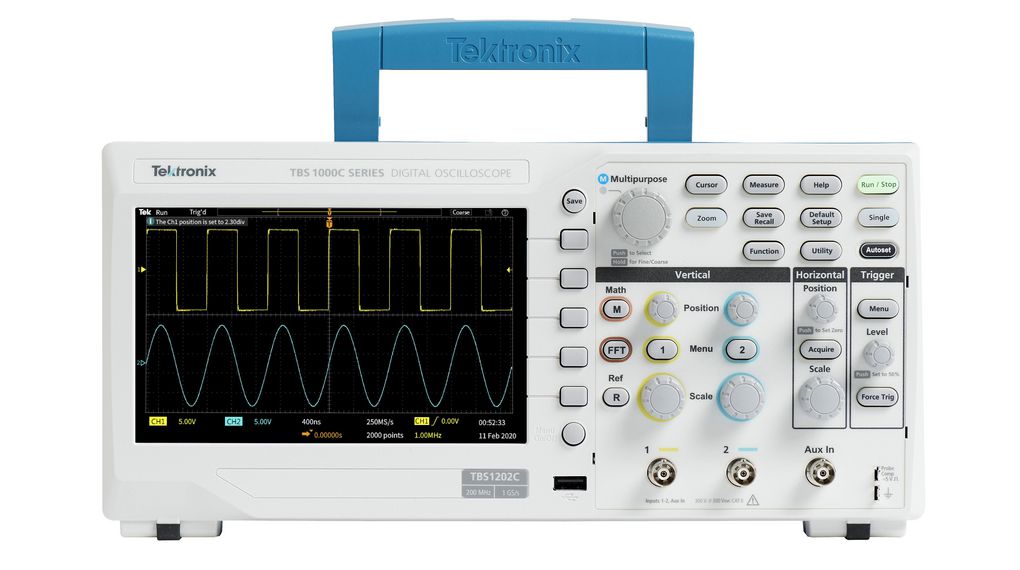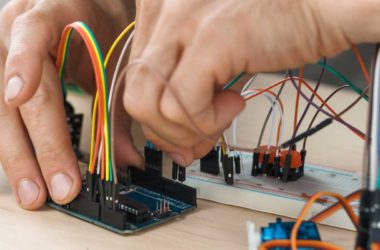An essential item of test equipment, oscilloscopes enable engineers and technicians to monitor electrical waveforms. By using oscilloscopes, any issues occurring within an electronic circuit can be identified easily, enhancing the manufacture, maintenance and repair of electronics.
1. What is an oscilloscope?
An oscilloscope is an instrument used to display and analyse the waveform of electrical signals. Typically, oscilloscopes display alternating current (AC) or pulsating direct current (DC) waveforms in the form of a graph where time is displayed from left to right on the horizontal scale and instantaneous voltage is shown on the vertical scale.
Oscilloscopes measure characteristics relating to both timing and voltage:
Timing:
Frequency and period
This is the number of times that a waveform repeats per second. The period is the number of seconds that each repeating waveform takes.
Duty cycle
The percentage of a period for which a wave is either positive or negative. Measured as a ratio, the duty cycle indicates how long a signal is “on” for versus how long it is “off” for in each period.
Rise and fall time
When a signal moves from a low point to a high point this is referred to as the rise time with the reverse of this being the fall time. Measuring this movement is useful when calculating how quickly a circuit can respond to signals.
Voltage:
Amplitude
This is a measure of the magnitude of a signal. Peak-to-peak amplitude measures the absolute difference between a high voltage point and a low voltage point of a signal. Whilst peak amplitude only calculates how high or low a signal is beyond 0V.
Maximum and minimum voltages
Oscilloscopes measure exactly how high and how low the voltage of a signal gets.
Mean and average voltages
This refers to the calculation of the average or mean of a signal in general or the average of a signal’s maximum or minimum voltage.
2. What can oscilloscopes be used for?
Ideal for testing, troubleshooting and researching, the oscilloscope can be used to monitor signal changes in circuits over time, to check printed circuit boards (PCBs) and to identify any faults, I/Os that are not working and timing errors. Whilst all oscilloscopes measure voltage and timing, when used with a transducer (which converts one type of energy into another), oscilloscopes can be used to measure almost anything.
Incredibly versatile, oscilloscopes are an essential piece of equipment used extensively by a diverse range of professionals including automotive technicians, researchers in laboratories, manufacturers of cell phones and engineers in the military and aviation industries to name a few. They are also used for compliance testing where an output needs to meet certain standards.
Oscilloscopes are relatively simple to use and are available in a wide range of models offering both basic and extensive functionality. As a result, they are useful for maintenance professionals and for domestic use alike.
3. What does an oscilloscope look like?

Digital oscilloscopes have a number of features on the front panel including:
- Display– this takes up a large proportion of the oscilloscope’s exterior and is where the waveform is displayed. Larger displays are easier to see and enable the user to monitor various elements of the waveform more effectively.
- Connectors– a number of different connectors will be provided on the front panel so that inputs for each channel can be displayed. Oscilloscopes often have more than one channel with many offering dual channels so that two signals can be displayed at the same time allowing for comparison.
- Controls– these include:
- Vertical gain/signal input sensitivity: measured in V/cm where each vertical division represents a number of volts.
- Timebase: alters the speed at which the trace crosses the screen horizontally.
- Trigger: allows the stabilisation of repetitive waveforms. Different types of trigger systems include; edge, threshold, slope and pulse triggering that respond to specific conditions.
4. Considerations when choosing an oscilloscope
With a number of oscilloscope models in the market, choosing the best device for your application can be a difficult task. A number of factors should be considered when deciding which model is most appropriate for your needs and these include the following:1. Type of oscilloscope
The way in which an oscilloscope is used will dictate the best type of model for your oscilloscope. Available as benchtop, handheld and PC-based versions, portability and size may be an important consideration depending on its intended application.
2. Bandwidth
As the range of frequencies is measured by an oscilloscope can vary greatly, it is essential that maintenance professionals ensure that their chosen device has a suitable bandwidth. The intended use of the oscilloscope will determine the bandwidth required which can range from 50MHz to 100GHz.
3. Sample Rate
This refers to the number of samples that an oscilloscope can obtain per second. Devices capable of gathering a larger number of samples will display the waveform more clearly and accurately.
4. Signal Integrity
An oscilloscope’s signal integrity denotes the equipment’s ability to represent the waveform accurately. How the oscilloscope is used will largely determine how important precision and accuracy of measurements is.
5. Channels
Oscilloscopes have inputs that can be either analogue or digital. Typically, there are 2 to 4 analogue channels per oscilloscope.
6. Probe compatibility
Probes are used to connect oscilloscopes to devices for testing. With a huge selection of probes available (both active and passive), ensuring that an oscilloscope is compatible with the type of probe you need will be of increasing importance for specific tests.

7. ApplicationsWhen testing electrical circuits and isolating any errors, applications for signal analysis, protocol decoding and compliance testing can enhance the use of oscilloscopes. As not all oscilloscopes are compatible with every application, researching relevant applications is essential to ensure that your device can work with the technology you require.
8. Additional functionality
Modern oscilloscopes often offer a variety of features in addition to the standard functionality. Depending on the intended use of the device, certain functionality may be desirable or required. Such features include:
- Ability to store waveforms for future reference
- Ability to display multiple waveforms at the same time for comparison
- Spectral analysis
- Usability with several different operating platforms
- Multicolour displays
- Ability to zoom in and zoom out for more accurate readings
- Battery power options
5. Why Tektronix?
Tektronix is a leading supplier of high quality, reliable and trusted oscilloscopes. All oscilloscopes from any of the Tektronix ranges benefit from unrivalled expertise, high quality components and a thorough quality checking process regardless of their price point.
Tektronix oscilloscopes use cutting edge technology to maximise performance, improve accuracy and increase capability to ensure that users can achieve the best results possible.
Find out more about the outstanding measurement performance of Tektronix 4 Series MSO mixed signal oscilloscope with the video below:
6. Recommended products
Mixed Signal Oscilloscope, 4x 1GHz, 6.25 GSPS
The 4 Series MSO offers better visibility into complex systems by offering four and six channel models with a 13.3-inch high-definition (1,920 x 1,080) display. This oscilloscope is very user friendly with an easy-to-use interface and a capacitive touchscreen.

Mixed Domain Oscilloscope, 2x 100MHz, 2.5GSPS
This oscilloscope provides an easy-to-use interface with touchscreen capabilities, offering digital phosphor technology with FastAcq™ highspeed waveform capture. With a variety of upgrade modules available this device is ideal for a number of different applications.

Oscilloscope, 4x 200MHz, 2GSPS
The TBS2000B Series provides easy operation and assists with quick hands-on learning. With 9-inch WVGA colour display, 10 vertical divisions and 15 horizontal divisions, users can see more of their signal and measurement results.

Oscilloscope, 2x 200MHz, 1GSPS
The TBS1000C Series Digital Storage Oscilloscope offers affordable performance in a compact design. With an innovative courseware system that integrates lab exercises with step-by-step instructions, this instrument is ideal for students.












